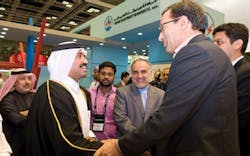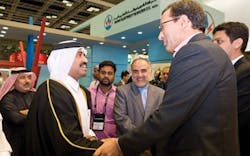New Cooling Water Technology to Boost Water Reuse, Help Cut Costs
By Kevin Milici
Industrial use of water gulps a whopping 20 percent of all the water consumed around the world. That's why water reuse on a large, industrial scale, is so critical when it comes to moving the needle on water conservation.
One area that offers an immense opportunity for re-use is in the vast amounts used for cooling water. Cooling systems rely on chemically treating the water so that the cooling properties are maximized and deposits don't gum up the works. But the process requires constant fine-tuning.
GE's TrueSense technology platform includes the Personal Water Analytics offline water testing system. Performing several water quality tests simultaneously from one sample saves time and increases productivity.
Now a next-generation technology called TrueSense by GE advances that process by monitoring, measuring and adjusting chemicals in the system more precisely and in less time. It further boosts productivity via web-based diagnostic tools and a portable instrument that's about the size of a small laptop. The result is a better performing system that uses less fresh water and less energy.
The numbers can be big, as a moderately sized industrial cooling tower can consume about 1.5 million gallons of fresh water a day when the water is cycled through the system three times. In these systems, some water is constantly bled off while some fresh water is constantly added to maintain the desired chemistry conditions. But better applied chemistry and automation can reduce the amount of fresh water required since it allows each gallon of fresh water to be used more productively.
For example, increasing the number of times the water is cycled through the industrial system from three to seven times can cut the amount of "new" water needed by more than 20 percent, saving over 300,000 gallons per day. Not only does it establish a greener footprint, but the cost of water for the company is also greatly reduced.
GE's water treatment technology focuses on three areas: preventing corrosion; reducing the build-up of deposits that impede heat transfer; and tackling microbiological problems. For example, mineral scales that deposit on metal surfaces can act as insulation, thereby impeding the heat transfer process. That can result in lost production and more energy use. In addition, microbiological growth can impact production and can lead to increased health risks such as Legionnaires' disease.
In a cooling system, the total operational costs take into account fresh water consumption, energy consumption, cooling tower treatment chemicals and wastewater discharge. While results may vary, GE's water team estimates that from a water perspective, total operating costs could be reduced by 25 percent or more when using TrueSense with the right treatment chemistry. In a moderately sized industrial cooling tower, a system running under optimal conditions could save nearly $400,000 per year in fresh water costs alone.
The system integrates several new and unique functions into one platform: direct online monitoring of critical water chemistries; personal instrumentation that cuts offline testing time; and a data analysis and display capability that provides insight into system status.
TrueSense is the result of simultaneous technical advances in the measurement and control of critical cooling system parameters, in both online and offline modes of operation. Key elements of the platform include Online for Cooling, Personal Water Analytics (PWA) and View.
• A core element of the platform is TrueSense Online for Cooling, a single unified online technology that can directly measure and monitor multiple core chemistries that are applied for effective cooling water treatment such as orthophosphate for corrosion control; proprietary polymers for deposit control; and the management of halogens like chlorine or bromine for microbiological control. The online technology provides a better understanding of cooling system status, enabling users to tighten control parameters to avoid or better respond to system variation and upsets, reduce water use and costs and to lower total cost of operation.
• Personal Water Analytics is a digital, field-deployable personal water sampling system that complements GE's online offering. PWA measures multiple critical parameters with a single 3 ml water sample, accomplishing this in minutes versus the half-hour that offline testing protocols typically require. Sampling times can be reduced by an estimated 80 percent. The system minimizes the need to maintain an inventory of reagent chemicals and equipment for testing and can cut testing costs.
• The final element of the platform is TrueSense View, a knowledge-management solution for system visualization, analysis, alarming and reporting. It arms plant personnel with the right information in terms of content, frequency and form, with the flexibility to have data stored either locally and/or on the Web. In addition, wireless features minimize deployment time and cost. IWW
About the Author: Kevin Milici is the global marketing leader of the monitoring solutions unit for water and process technologies, GE Power & Water, located in Trevose, PA. In this role, Milici directs the marketing activities of GE's advanced detection, control, communications and monitoring solutions for industrial water applications. He holds a B.Sc. degree in Environmental Science, and an M.B.A from the University of Pittsburgh.
Past IWW Issues

